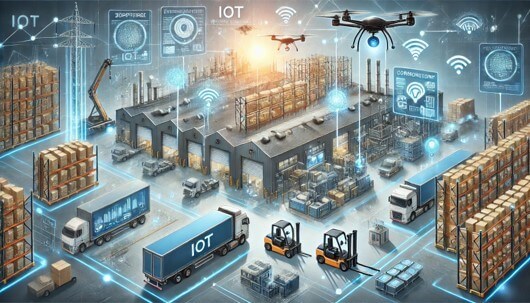Antennas, Antenna Cables, Wireless Products: Technical Articles
Supply Chain Management with IoT: Applications and Wireless Technologies
IoT in Supply Chain Management: Revolutionizing Logistics Through Connectivity

The Internet of Things (IoT) has swiftly emerged as a transformative force in multiple industries, and the supply chain is no exception. By leveraging IoT, supply chain management (SCM) has evolved into a highly connected, real-time system that significantly enhances efficiency, transparency, and responsiveness. Here's a look at how IoT is impacting SCM, the applications driving this change, and the wireless technologies involved.
Applications of IoT in Supply Chain Management:
- Real-time Tracking and Visibility : By embedding sensors and RFID tags in goods and vehicles, organizations can monitor the real-time location and status of their products. This enables businesses to offer accurate delivery estimates, mitigate risks, and quickly respond to any disruptions with enhanced IoT asset tracking.
- Inventory Management: IoT devices can provide accurate data on inventory levels, helping companies avoid overstocking or stockouts. This real-time inventory tracking means companies can optimize warehouse space and improve inventory turnover rates.
- Fleet Management: With the help of GPS and IoT sensors, businesses can track vehicle locations, monitor driver behavior, and ensure efficient routing. This not only reduces transportation costs but also minimizes delays.
- Temperature and Condition Monitoring : For perishable goods or sensitive equipment, maintaining optimal conditions during transportation is vital. IoT sensors, can monitor temperature, humidity, and other environmental factors, ensuring the quality and safety of goods. ( IoT in Agriculture )
- Predictive Maintenance : IoT can forecast when equipment is likely to fail, allowing companies to perform maintenance just in time. This reduces downtime, extends equipment lifespan, and saves costs.
- Automated Sorting and Handling : In warehouses, IoT combined with robotics can automate tasks such as sorting products, optimizing storage, and even packing goods. This streamlines operations and reduces the need for manual labor. ( Smart Factory )
Wireless Technologies Powering IoT in SCM:
- RFID (Radio-frequency identification) : A key player in SCM for years, RFID tags tags store product information that can be scanned wirelessly, making tracking and inventory management highly efficient.
- Wi-Fi: Though primarily used for internet connectivity, Wi-Fi antennas also plays a role in connecting devices in close proximities, like within warehouses.
- Bluetooth and BLE (Bluetooth Low Energy) : Bluetooth antennas and BLE ideal for short-range communications, they're often used in wearable devices, pallet trackers, and other localized applications.
- LoRa (Long Range) : A low-power wide-area network (LPWAN Technologies) protocol, LoRa is perfect for applications where devices need to send small amounts of data over long distances while preserving battery life.
- NB-IoT (Narrowband IoT) : Another LPWAN technology, NB-IoT focuses on indoor coverage, low cost, long battery life, and high connection densities. It’s particularly suited for applications that don't need frequent communications.
- 5G: The next generation of mobile communication technology, 5G offers faster speeds, lower latency, and the ability to connect many devices simultaneously. As it rolls out globally, 5G will bolster real-time data transfer in supply chains.
- Satellite Communication : For global tracking, especially in areas without conventional network coverage, satellite communication remains an essential tool.
The merger of IoT with supply chain management is ushering in a new era of hyper-efficient, transparent, and responsive logistics. As wireless technologies continue to advance and evolve, we can anticipate further enhancements in SCM, empowering businesses to deliver unparalleled value to their customers. In this digital age, those who leverage IoT's potential stand to gain a competitive edge in an increasingly interconnected global marketplace.







